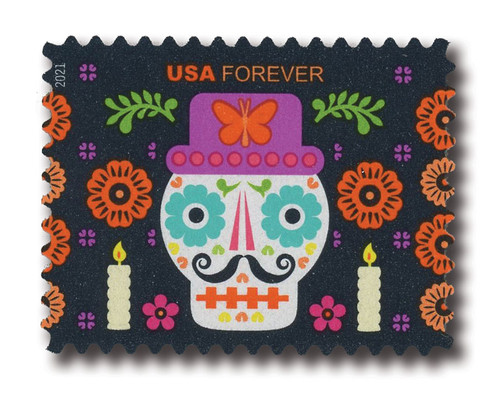
# 5643 - 2021 First-Class Forever Stamps - Day of the Dead: Boy's Skull
US #5643
2021 Boy’s Skull – Day of the Dead
- One of four stamps that became the first US postage stamps to honor the Mexican celebration known as the Day of the Dead (Día de los Muertos)
Stamp Category: Commemorative
Set: Day of the Dead
Value: 58¢ First Class Mail Rate (Forever)
First Day of Issue: September 30, 2021
First Day City: El Paso, Texas
Quantity Issued: 35,000,000
Printed by: Banknote Corporation of America
Printing Method: Offset
Format: Panes of 20
Tagging: Phosphor, Overall
Why the stamp was issued: To honor the Day of the Dead celebration and its traditional sugar skull treats, memorial candles, and marigold decorations.
About the stamp design: Pictures a stylized sugar skulls decorated to resemble a young boy. Additional details include lit candles, marigolds, and other colorful details representing popular Day of the Dead traditions. Artwork by Luis Fitch.
First Day City: The First Day of Issue Ceremony was held at the El Paso Museum of Art in El Paso, Texas. Day of the Dead celebrations have become especially popular in Texas and other states closest to the US-Mexico border.
About the Day of the Dead set: The first US stamps to honor this traditional Mexican holiday. All four stamps picture traditional elements of the celebration. They were issued to recognize the importance of the holiday to US citizens with Mexican heritage as well as the Day of the Dead’s growing popularity within the United States. Each design includes colorful artwork by Luis Fitch.
History the stamp represents: Day of the Dead is celebrated throughout Mexico and other Latin American countries. While many celebrations include altars to the deceased and visits to cemeteries, several places have their own traditions unique to their communities.
In the Mexican town of Pátzcuaro, families that have lost children set out tables of sweets, fruits, and candles on November 1. On November 2, they light candles and take boats resembling butterflies to an island cemetery to celebrate deceased adults.
In Ocotepec, families that have lost someone in the past year open their doors to visitors. The visitors bring candles and receive tamales in return. In recent years, some cities see costumed children going door-to-door or asking passersby for candles or money.
Many communities perform traditional dances. In Michoacán, there’s La Danza de los Viejitos (The Dance of the Old Men). Young men and boys dressed as old men start walking with canes, then jump and dance energetically. In Oaxaca, there’s Danza de los Diablos (Dance of the Devils), which symbolizes African slaves breaking away from their Spanish captors. There’s also La Danza de los Tecuanes (The Dance of the Jaguars), which portrays a fight against a fierce beast.
All of these local traditions help make Day of the Dead celebrations unique to their communities.
US #5643
2021 Boy’s Skull – Day of the Dead
- One of four stamps that became the first US postage stamps to honor the Mexican celebration known as the Day of the Dead (Día de los Muertos)
Stamp Category: Commemorative
Set: Day of the Dead
Value: 58¢ First Class Mail Rate (Forever)
First Day of Issue: September 30, 2021
First Day City: El Paso, Texas
Quantity Issued: 35,000,000
Printed by: Banknote Corporation of America
Printing Method: Offset
Format: Panes of 20
Tagging: Phosphor, Overall
Why the stamp was issued: To honor the Day of the Dead celebration and its traditional sugar skull treats, memorial candles, and marigold decorations.
About the stamp design: Pictures a stylized sugar skulls decorated to resemble a young boy. Additional details include lit candles, marigolds, and other colorful details representing popular Day of the Dead traditions. Artwork by Luis Fitch.
First Day City: The First Day of Issue Ceremony was held at the El Paso Museum of Art in El Paso, Texas. Day of the Dead celebrations have become especially popular in Texas and other states closest to the US-Mexico border.
About the Day of the Dead set: The first US stamps to honor this traditional Mexican holiday. All four stamps picture traditional elements of the celebration. They were issued to recognize the importance of the holiday to US citizens with Mexican heritage as well as the Day of the Dead’s growing popularity within the United States. Each design includes colorful artwork by Luis Fitch.
History the stamp represents: Day of the Dead is celebrated throughout Mexico and other Latin American countries. While many celebrations include altars to the deceased and visits to cemeteries, several places have their own traditions unique to their communities.
In the Mexican town of Pátzcuaro, families that have lost children set out tables of sweets, fruits, and candles on November 1. On November 2, they light candles and take boats resembling butterflies to an island cemetery to celebrate deceased adults.
In Ocotepec, families that have lost someone in the past year open their doors to visitors. The visitors bring candles and receive tamales in return. In recent years, some cities see costumed children going door-to-door or asking passersby for candles or money.
Many communities perform traditional dances. In Michoacán, there’s La Danza de los Viejitos (The Dance of the Old Men). Young men and boys dressed as old men start walking with canes, then jump and dance energetically. In Oaxaca, there’s Danza de los Diablos (Dance of the Devils), which symbolizes African slaves breaking away from their Spanish captors. There’s also La Danza de los Tecuanes (The Dance of the Jaguars), which portrays a fight against a fierce beast.
All of these local traditions help make Day of the Dead celebrations unique to their communities.







